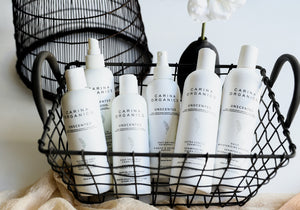
The Marketplace
Buying products in a market ripe with greenwashing makes it hard to discern which "Natural" products are actually natural, organic, and earth friendly, and which products simply have a few organic or natural products in them. Have you ever read the ingredients on the back of a product you are about to use on your, or your child's, body and wondered a) what everything actually is and, b) if those chemicals are safe to use?
You would think they would be, but surprisingly many of them come with health warnings that you would never know of or hear about unless you were a scientist, lab technician, or the product manufacturer. Commonly used chemicals such as Sodium Lauryl Sulfate (used as a foaming agent), Diethanolamine or DEA (used as a foam booster), Propylene Glycol (assists in moisture retention) and Imidazolidinyl Urea (preservative) are not just hard to pronounce, but are also considered by many to be harmful ingredients. To be clear, these are only four of HUNDREDS of examples of ingredients that should be avoided.
Informing Yourself: How (and where) to learn more about the hazardous ingredients in everyday household products...
Many answers can be found on the National Institute of Health’s website (NIH). This website has a household products database that allows you to search for thousands of different chemicals and provides specific information on each one of them. This is a reputable source. NIH also gives a list of other names each chemical is also known by. You can then cross-reference these chemicals with products to assess the ingredient list.
The database also presents a list of common household brand name products with which you can compare ingredient lists. You can further research specific ingredients by reading the health studies, which summarize the health-related effects from the Hazardous Substances Data Bank (HSDB). Let’s try searching an ingredient together. Follow these 6 simple steps and you’ll discover what most personal care product manufacturers’ don’t want you to know.
STEP 1
Go to the internet and log onto www.nih.gov/ . This will get you to the National Institute of Health’s home page.
STEP 2
In the SEARCH box at the top right of the screen, type in the words HOUSEHOLD PRODUCTS DATABASE and click on the SEARCH button. This gets you to all the different listings available for review. But the one you want first is called Household Products Database (Health and Safety Information on ...) Click on this one.
STEP 3
You will see a picture of a blue bucket with cleaners, scrub brushes and sponges in it. Click on either the INGREDIENTS tab on the top of the page or the INGREDIENTS listing in the left column of the page. You’ll then find yourself at a page that shows an ingredient list in alphabetical order.
STEP 4
Let’s look up Sodium Lauryl Sulfate. Click on the letter “S” at the top of the page. You should now see ingredients starting with the letter “S”. Scroll down the list and click on sodium lauryl sulfate. Your search results will show a page that reads Chemical Information and Products that contain this ingredient.
STEP 5
Start by familiarizing yourself with the “Synonyms”. These are the other similar names that refer to sodium lauryl sulfate. Next, beside Health Studies, click on the Human Health Effects from Hazardous Substances Data Bank (HSDB). A “pop-up window” will appear that will show you the Human Toxicity Excerpts. This is where it gets interesting because it will list the type of reactions and toxicity results found when using this particular ingredient. Additionally, there is a Table of Contents to the left of these excerpts that go into further detail about this ingredient.
You should see headings that read Human Health Effects, Emergency Medical Treatment, Animal Toxicology Studies, etc. There are thirteen headings in all and each one describes a multitude of potentially harmful situations related to using this particular ingredient.
STEP 6
Now Click out of the Human Health Effects from Hazardous Substances Data Bank (HSDB) by pressing the white “X” in the red box in the top right corner of the “pop-up window”. You should be back on the page that reads Chemical Information and Products that contain this ingredient.
Scroll down to the list of product names. All of these products use sodium lauryl sulfate and by the time you read this list it will probably need updating, because this ingredient, like so many others, is very inexpensive to use, mixes easily with water and thickens well with ordinary table salt. Add a little color, synthetic fragrance, chemical preservative and guess what? You’ve got yourself the most common shampoo formula in the world, but at what price?
Continue scrolling down the list of product names and click on any one that interests you. When you do, you’ll get specific information about that product such as Brand and Manufacturer details as well as Health Effects, Handling & Disposal recommendations, and a list of all the other ingredients on that product’s label. Now remember, up to this point we’ve only researched one ingredient out of hundreds that should be avoided!
Just imagine the combined effect of all ingredients in the products you use. We encourage you to use the ingredient list on the back of your current bottle of shampoo and use these 6 steps as a guide for you to become more familiar with the health issues surrounding these chemicals.
Now for those of you with a skin or scalp problem that were considering using or are currently using a hydrocortisone product, repeat steps 1 through 6 and research the Human Health Effects of hydrocortisone. You will be shocked and amazed at what you read!



